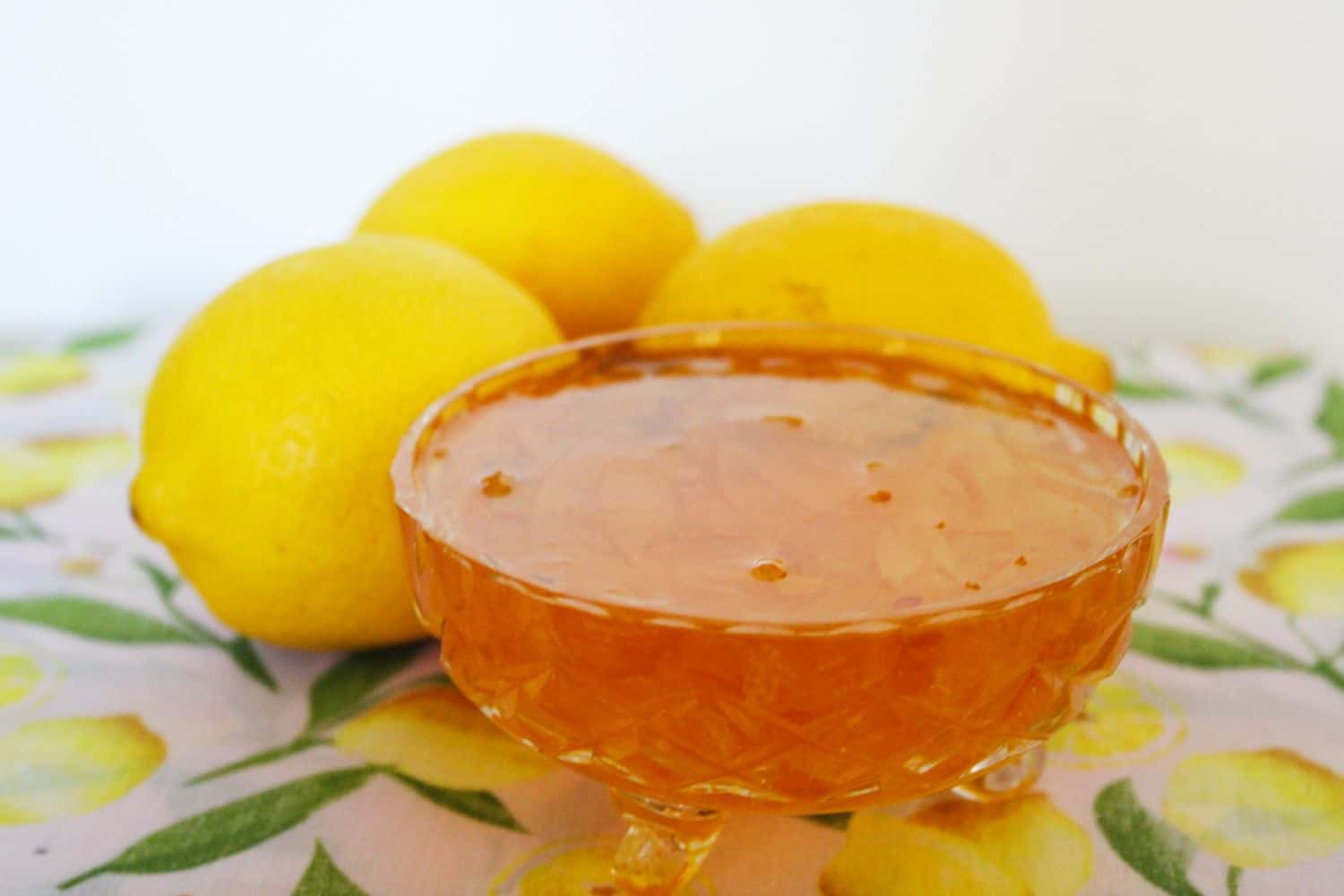
Lemon Marmalade has always been a favourite with my parents, my father in particular. He has been without his homemade breakfast condiment for a few weeks now and has politely let us know that a jar of shop-bought marmalade is not on his agenda.
As fortune would have it, a friend presented me with some beautiful, homegrown lemons and I have set to work. This is a classic method of making marmalade. It requires just three ingredients, and one of them is water. That is all that you need to make this fresh-flavoured condiment.
If you think that making marmalade is difficult, I want to assure you that it is easier than you may think. Although there is a great deal of science involved, it just requires that you follow a few simple steps.
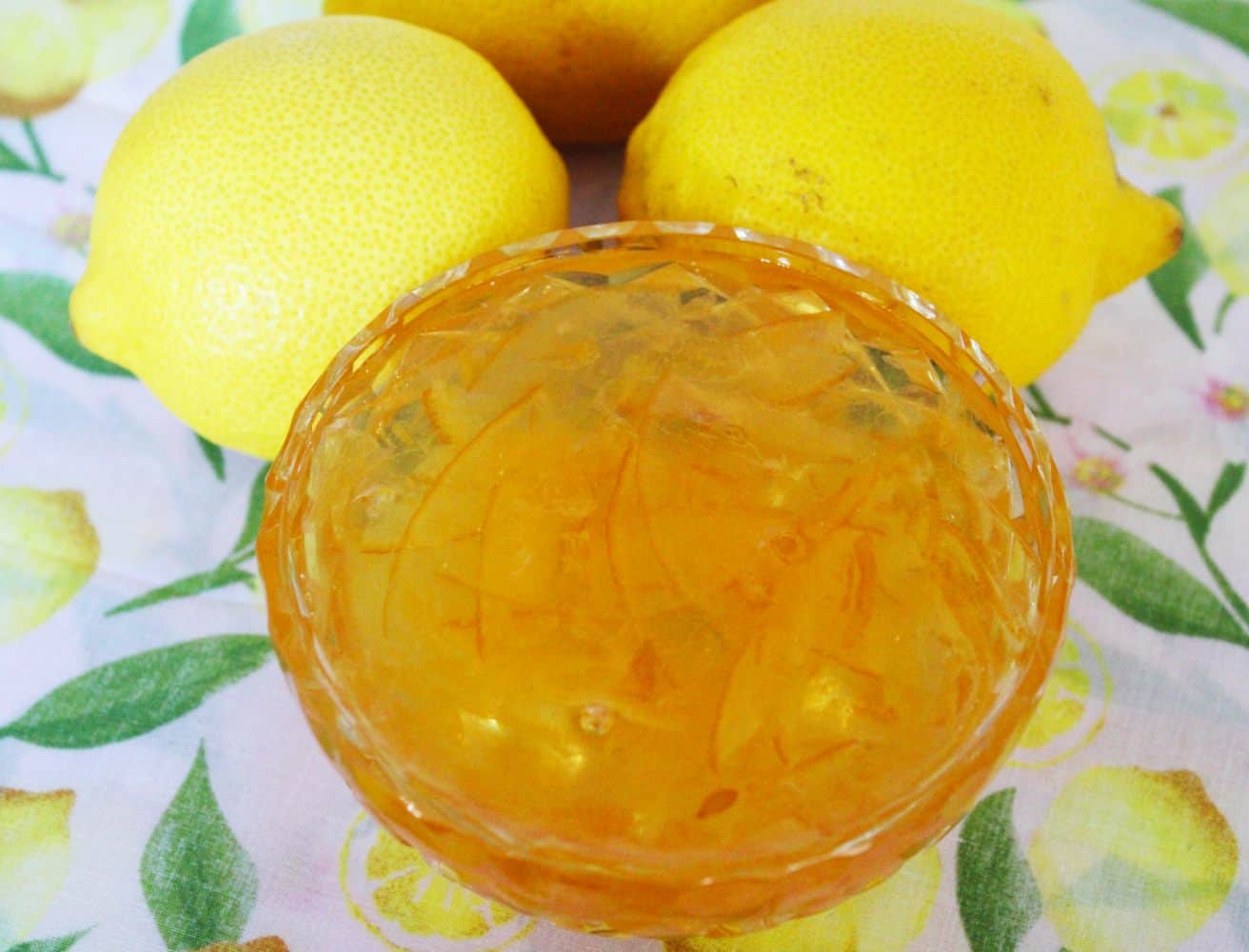
Let me tell you a little about Marmalade:
Marmalade is a favoured preserve on many breakfast tables. It’s easy to appreciate that this zesty, tangy preserve is a great way to start the day.
Marmalade is only made from citrus fruits, unlike jam, which can be made from any variety of fruit. Moreover, citrus fruits are rich in naturally occurring pectin. High amounts of pectin and acid, such as in citrus, help the marmalade to set, making it ideal for preserving. As such, it is not necessary to buy special jam-setting sugar.
I regard homemade jams and spreads as luxury items. It’s not that they are expensive to make, especially when the fruit is a gift, but there is an investment of time. However, having jars of marmalade that you have made yourself is tremendously satisfying.
The flavours are bright and clear and remember, there are just three ingredients. Compare that with the labels of some commercial varieties which often have a large range of additives.
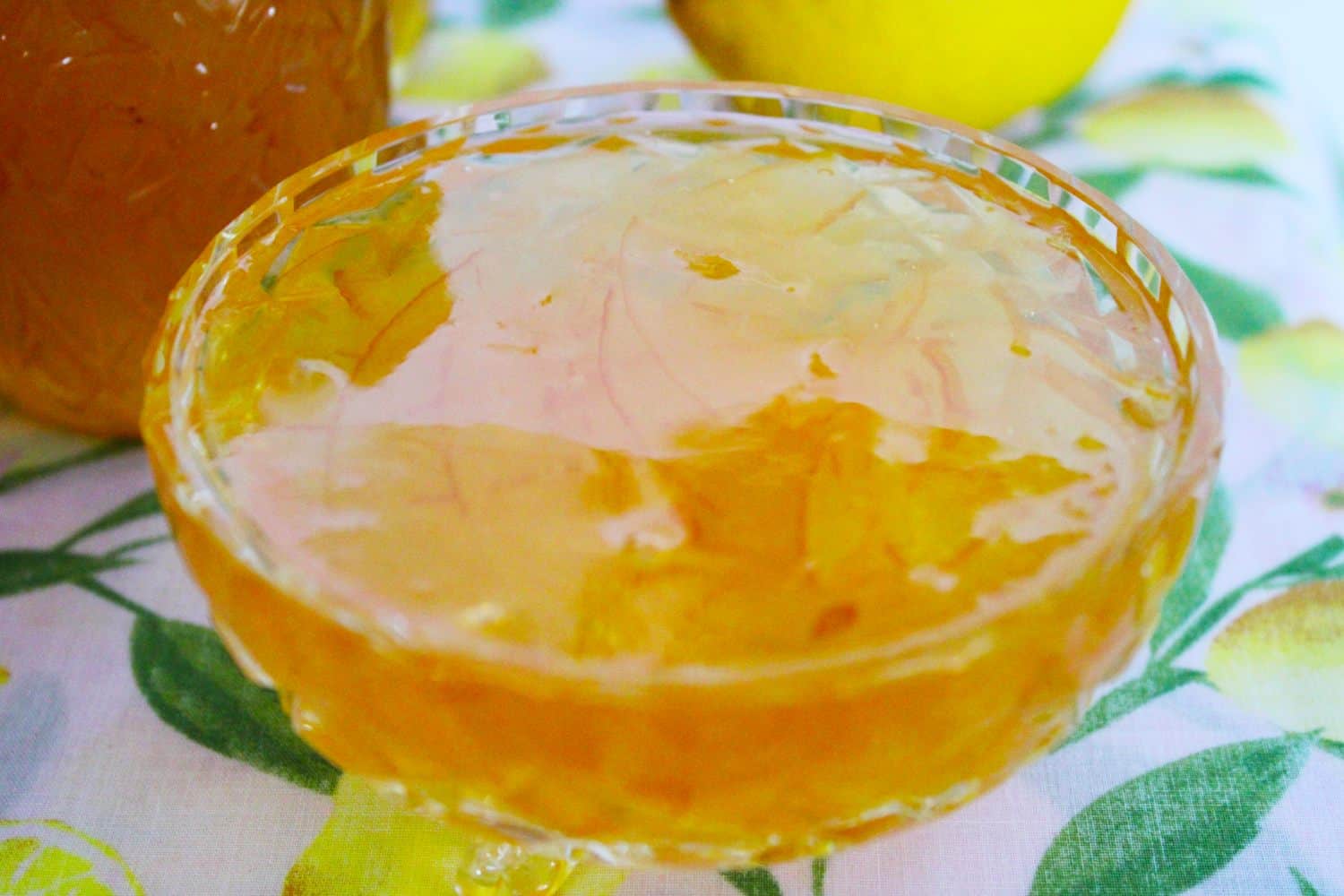
Ingredients in my Three Ingredient Lemon Marmalade:
Lemons:
Given that we will be using the entire fruit, it is preferable to use home-grown or organic lemons. Commercially produced lemons generally have a wax coating and may have been sprayed.
Sugar:
I use regular, granulated sugar. It is a large amount of sugar but it does much more than sweeten the marmalade. Its main function is to combine with the pectin and fruit acids to form a gel. In addition, it acts as a preservative that inhibits the growth of mould.
I don’t recommend reducing the amount of sugar as it may interfere with the setting and preservation.
Water:
I have used filtered water but regular tap water is also fine.
How to make Three Ingredient Lemon Marmalade:
Making the marmalade is a two-day process. On the first day, you slice the lemons very finely and put them into a large bowl with water to soak overnight. Soaking the fruit serves two purposes.
Firstly, it softens the peel and secondly, it helps release the pectin required for setting the jam. On day two you cook the fruit and add the sugar.
When setting point is reached, as outlined in the recipe instructions, I remove the saucepan from the heat and set it aside for 10 minutes. This will help the fruit to settle and evenly distribute when poured into the jars.
Without settling, the fruit will rise to the top of the marmalade. And finally, ladle it into jars and smile with satisfaction at the result.
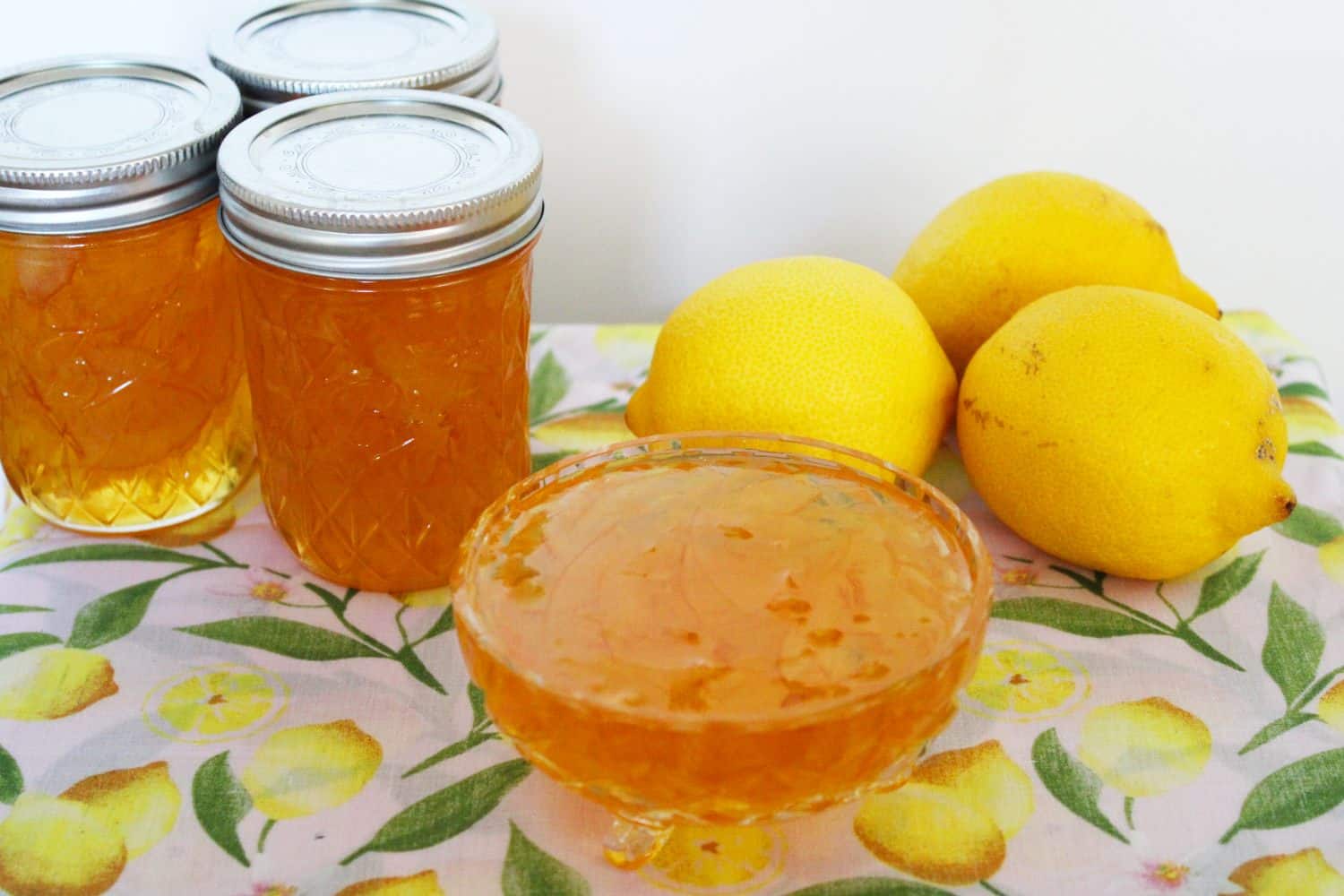
Tips for success:
You will not need any special equipment to make this recipe. However, a large saucepan is essential. When you add the sugar, it foams up enormously. Without a very large saucepan, there is the risk of it boiling over.
Your jars and their lids must be sterilised. I do this by heating them in the oven as outlined in the recipe.
As we are using the whole fruit, it is best to use organic or home-grown fruit. However, if you are only able to access commercially grown lemons, they need to be thoroughly cleaned.
Always use fruit which is in good condition and ideally some which are slightly under-ripe as they will contain more pectin. Bruised or damaged fruit may spoil the jam, causing it to deteriorate quickly.
It is important to cook the peel until it is tender before you add the sugar. Once you add the sugar the peel will no longer soften. After adding the sugar it is necessary to completely dissolve it before bringing the mixture back to the boil.
I find it best to check for setting point by checking a small amount of marmalade on a chilled plate. I use the “wrinkle” test, as detailed in the recipe. After reaching setting point, set the marmalade aside for 10 minutes to allow the fruit to settle.
Ladle the marmalade into hot jars to avoid the glass breaking.

Other uses for these ingredients:
We love lemons, and some of our other favourite ways to use them are:
- Individual Lemon Curd Meringues
- Classic Lemon Curd
- Gluten-Free Lemon Madeleines
- Belgian Lemon Tea Cake
- Quick and Easy Lemon Ice Cream
More delicious condiments and edible gift ideas:
- Apricot Jam
- Fresh Peach Chutney
- Easy Plum Jam
- Classic Lemon Curd
- Dill Pickled Cucumbers
- Sweet Chilli Sauce
- Balsamic Glaze
- Preserved Chillies in Oil

When it comes to using the Lemon Marmalade:
First and foremost, this bright and zesty condiment with the zingy flavour of lemon is a great wake-up call, perfect when slathered on your morning toast.
However, there are other ways in which to use it:
- A sticky glaze for chicken drumsticks;
- Make a sauce for pork tenderloin;
- Glaze a Christmas ham;
- Make crostini with goat cheese and prosciutto;
- Bake a lemon cake and make a glaze with the marmalade;
- Serve with Coconut Scones by A Baking Journey.
This refreshing condiment highlights the bright, tangy flavours of lemon. Although it is an ideal toast topping there are other ways in which to enjoy this condiment.
When you try it you will realise that there is no comparison between homemade marmalade and the commercially produced varieties.
Do let me know in the comments below when you have tried this delicious recipe.
Alex xx
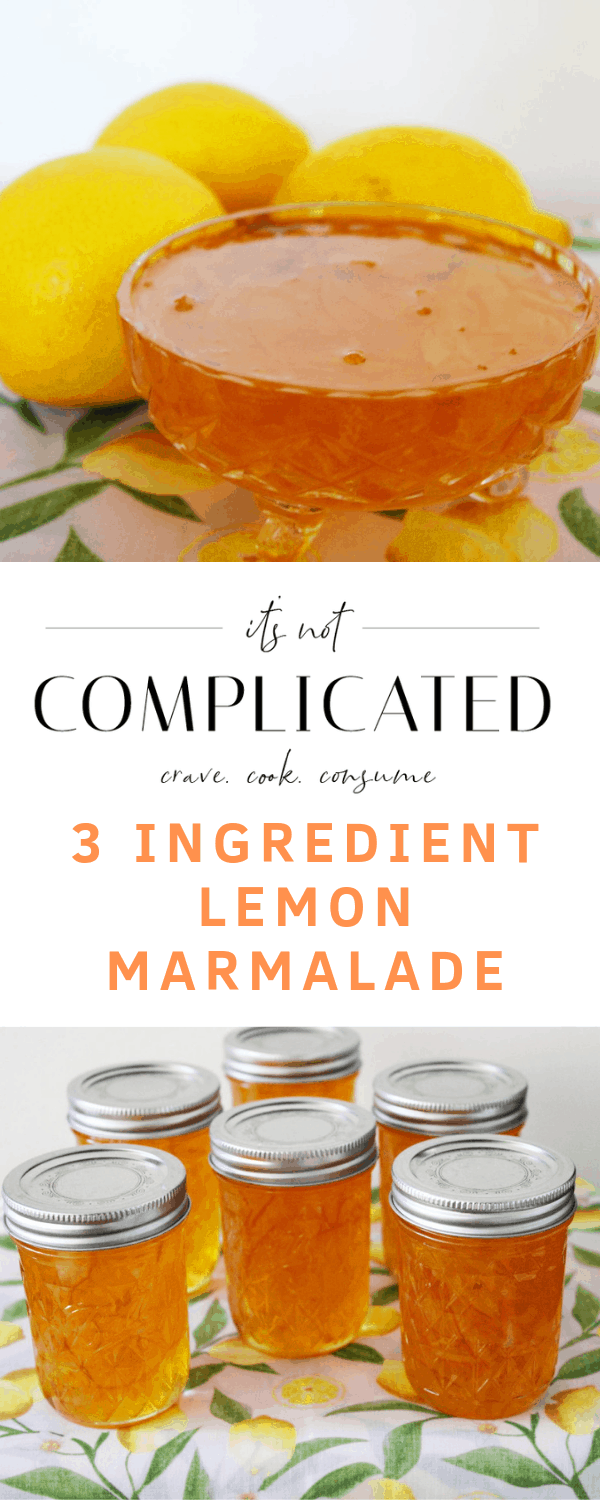
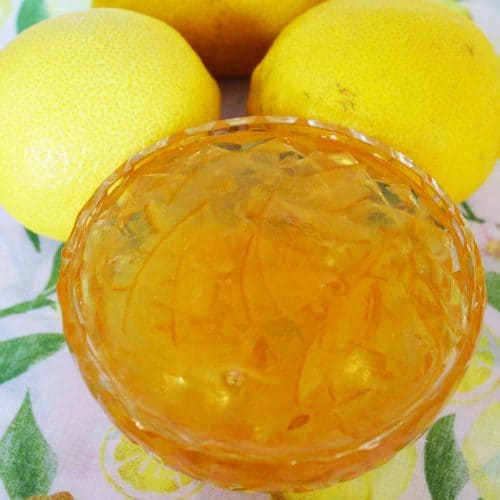
Three Ingredient Lemon Marmalade
Equipment
- 9 x 250ml Jars
Please note:
For accuracy, when weights are provided, we recommend weighing your ingredients. This will produce the best results. All oven temperatures listed are for fan forced.
Ingredients
- 500 g (17.5 ounces) lemons See Notes 1 & 2
- 6 cups (1.5 litre) water
- 8 cups (1.8kg) sugar
Instructions
Please Read First:
- Preserve making is quite simple, but we do recommend reading the recipe through first and following these tips:– weigh your ingredients for accuracy.– do not double the recipe or alter the quantities.– yes, it’s a lot of sugar. It’s also a lot of water. When making marmalade, the sugar is not just a sweetener, it also assists with gelling and preservation. When prepared properly, your end result will be the perfect mix of sweet, citrus tang and bitter, as marmalade should be. This is an old-fashioned recipe (my great great grandmothers.) – use a very large saucepan as the marmalade needs to rapidly boil and will foam up and you don’t want it to overflow.– ensure the marmalade reaches setting point. Keep in mind the marmalade will be very liquid while hot. Do not over boil as you will risk burning the marmalade.– allow 24-48 hours once jarred for the pectin to activate and the marmalade to set properly.– if after this time your marmalade hasn’t set, it likely wasn’t cooked for long enough initially. In this case, add the marmalade back to a clean saucepan with the juice of a fresh lemon. Bring back to the boil and start testing after 5 minutes of rapid boiling.
To sterilise the jars:
- Preheat the oven to 130 Degrees C (270F).Use glass jars with an airtight, metal lid. Wash them either in the dishwasher or by hand in hot soapy water, and rinse well. Check that the metal lids do not have rubber inserts. If they do, allow them to air dry.(See Note 9)
- Place upright jars and lids on a baking tray. Heat in the oven for at least 20 minutes, then remove and immediately fill with marmalade.
For the Lemon Marmalade:
- Place 2 saucers or small plates in the freezer, ready to check for the setting point of your marmalade.
- Thoroughly wash the lemons. Remove each end of the lemons and cut the lemons into quarters lengthways. Holding two of the quarters together, slice as thinly as possible and remove any seeds.
- Place the lemon slices in a non-reactive bowl. See Note 3. Add 6 cups of water, cover the bowl and leave the lemons to stand overnight.
- The following day, place the lemons and water into a large, non-reactive saucepan. – See Note 4.
- Over medium-high heat, bring the fruit and water to the boil. Boil for approximately 15 minutes or until the lemon peel is tender, stirring occasionally with a long-handled wooden spoon. – See Note 5. The time may vary slightly depending on the variety of lemon and the thickness of the slices.
- Add the sugar and stir well to dissolve it. After dissolving the sugar, return the fruit to the boil, stir occasionally and skim to remove any foam. Continue to stir until the marmalade reaches setting point, about 20 minutes. – See Note 6Remove from the heat to conduct the wrinkle test. If not set, continue to boil for another 1 minute and then test again.
- To test for setting point, I use the “wrinkle” test. Take one of your saucers from the freezer and pour a small amount of marmalade onto it. Let it cool for a minute then push against the marmalade with the tip of your finger. If the surface wrinkles it means setting point has been reached. Alternatively, if you are not confident checking this way or are not experienced at making marmalade, you can use the fail-safe method of using a jam/candy thermometer which you clip to the side of your saucepan. When attaching your thermometer, make sure that the base is not touching the bottom of the saucepan. Your marmalade has reached setting point when the temperature reaches 104.5 degree C or 220 degrees F. It will still be liquid at this point, and will set as it cools.
- Take the mixture off the heat and let the marmalade stand for about 10 minutes. This will help evenly distribute the fruit throughout the jars.
- Remove your jars from the oven and carefully ladle the marmalade into the heated, sterilised jars. You need to be very careful. Splashing yourself with hot marmalade will result in a very serious burn. I suggest you have clothing with long sleeves and ensure that you do not have children nearby. Put lids on jars immediately, and seal well – being careful to use a cloth or oven gloves to handle the jars/lids.
Video
Notes
- The weight of the lemons, before trimming the ends and removing the seeds, was 530 gm/1.2 lbs. We use Eureka or Lisbon lemons for this recipe.
- As the peel is such an important part of the marmalade, I like to use organic or home-grown lemons. Commercially produced lemons generally have a wax coating and may have been sprayed. If this is all that you can obtain, you can clean the lemons by placing them in a colander and pouring over freshly boiled water. Then, scrub them gently with a nail brush while holding them under cold running water.
- Non-reactive bowls and saucepans are stainless steel, glass, ceramic or enamelled cookware. Aluminium, copper and iron bowls or pans are reactive. Acidic foods, such as lemons, may discolour and take on a metallic taste if these are used.
- A large saucepan is essential. When you add the sugar, it foams up enormously. Without a very large saucepan, there is the risk of it boiling over.
- To stir, use a long-handled wooden spoon. Metal will become dangerously hot.
- Boiling time depends on several factors, the width of your saucepan and the heat at which the fruit is boiled.
- The Marmalade will be shelf stable for approximately 12 months.
- Your marmalade will be very liquid when you add it to the jars so please don’t be concerned. It will continue to thicken as it cools. Leave it for 24-48 hours and then check again. If it is still runny, you can re-boil the marmalade. Empty the contents of the jars back into the saucepan and bring to a boil. To increase the pectin and help the marmalade to set, you can add the juice of half a lemon. Boil for a few minutes and test again.However, if the marmalade was initially boiled too long, it can still result in it not setting as the pectin may have been damaged.
- Properly sterilising your jars is an essential process to remove bacteria which could cause your preserves to spoil. I prefer to sterilise jars in the oven. To do this, preheat your oven to 130 Degrees C (270F). Use glass jars with an airtight, metal lid. If recycling jars, ensure that the jars do not have cracks or chips and the lids are in good condition. Discard any lids that are pitted or rusted. Wash the jars and lids either in the dishwasher or by hand in hot soapy water, and rinse well. Do not dry them with a tea towel. Place upright jars and lids on a baking tray. If you are using kilner jars with rubber seals, be sure to remove the seals before placing the jars in the oven. The dry heat of the oven would damage the seals. Boil the seals separately in a saucepan for about 10 minutes. Heat the jars in the oven for at least 20 minutes. When your preserves are ready to bottle, use thick oven mits or jar tongs to remove the jars. Do not place them on a cold surface as they may shatter. I place mine on a wooden chopping board which I cover with a tea towel. Always sterilise a few more jars than you think you will need. It is better to have too many jars than not enough.
- Please note, the nutritional information is based on one 250ml jar. Please take this into account, as you most likely won’t be consuming a whole jar in one sitting. The nutritional information is an estimate only.
Nutrition Estimate:
Nutritional Disclaimer:
The nutritional information is an estimate only, and is derived from online calculators. For accurate results, we recommend calculating the nutritional information based on the ingredients and brands you use.

Winona
Fantastic recipe. Enjoying some on toast with my coffee now. Thanks!
Alexandra Cook
Thank you, Winona!
Alex xo
Dave
My go to recipe! Thank you.
Alexandra Cook
Love it, Dave!
Thank you, Alex xo
Judy Morris
I’m looking forward to trying your recipe. I have always used apple peels with low pectin fruit jams and for those made from liquid (like high amounts of lemon juice) also grated tart apple for added pectin amounts. I take the peels out before jarring the jams and eat the candied peels.
Alexandra Cook
Hello Judy,
I hope you’ll enjoy it, and I am so curious to give it a try with the apple myself! While I have added apple to jam over the years, I have not done it with marmalade. I can imagine it would be lovely with the lemon.
Alex xo
Meg
Easy, delicious and great flavor.
Alexandra Cook
Thank you, Meg! So happy you enjoyed the recipe 🙂
Alex xo
Amanda
My previous experiences with preserves have usually involved me resorting to a lot of added pectin. I have previously struggled with other marmalade recipes but I tried this recipe yesterday and it worked perfectly!
I am very proud to have made marmalade that not only set by itself, but that wasn’t overset. I hate how thick the commercial varieties are and as a result, have wanted to switch to making my own.
I did read the recipe thoroughly, including the notes, and was very grateful for all of the tips and tricks.
I measured everything carefully, and tested using both a candy thermometer and the cold plate. I prefer the latter as it’s nice to get ‘a feel’ of the wrinkle.
I may need to invest in a bigger saucepan for next time as it was touch and go for it boiling over a couple of times, but I kept a careful eye on bit and it all worked out fine.
Overall, thrilled with the results. It is a very easy recipe that works, but I also recommend that you read through everything first.
Alexandra Cook
Hi Amanda,
Thank you so much for giving the recipe a try, and for such detailed feedback.
I am so glad to hear you had success with it and are thrilled with the results.
Appreciate you taking the time to comment!
Alex xo
Lynn
I have made my share of jams and jellies in the past. Most recipes are fool proof or at least in the ball park, but this recipe didn’t turn out at all. Since others had trouble with it being too runny, I thought I’d go for a safer route and boil until it reached the suggested temperature of 270F. I only got it up to about 240F (using both a candy and digital thermometer) and ended up cooking it too long. Funny it had a nice consistency – not runny, but it was brown and disgusting. It wasn’t editable.
Alexandra Cook
Hi Lynn,
I think there has been some confusion – the suggested temperature of 270 F is the oven temperature for the sterilising of the jars.
The suggested temperature for cooking the marmalade is only 220 F.
The marmalade is brown because it is overcooked and the sugars have caramelised.
Kind regards, Alex
Bob Morris
The recipe works perfectly when followed correctly. Bob Morris
Karen Debono
I’ve made a couple of batches today with our own lemons. It tastes incredible, and am looking forward to seeing the consistency over the coming days. Thank you so much for sharing your family recipe!
Alexandra Cook
Hi Karen,
So happy to hear this 🙂
I appreciate your comment and please reach out any time if you have any queries or are looking for a specific recipe! Alex xo
Sarah
Hello,
Will this recipe also work with oranges?
My lemon tree is behind this year after a very vigorous prune – but I can see that it will be a good year for oranges in the next few months!
Alexandra Cook
Hi Sarah,
We use a different ratio for oranges, but you can find my recipe linked:
Orange Marmalade Recipe
Please let me know if you give it a try! Alex xo
Diana
Too much water. Just impossible to set.
Alexandra Cook
Hello Diana,
Thanks for your comment, and I am sorry to hear you haven’t had success – this is my Great Great Grandmother’s recipe, and I’d love to help you work out what has happened. 🙂
If your marmalade hasn’t set, it hadn’t reached setting point, and this is likely because it hasn’t been boiled for long enough.
Just a few other questions: did you make any alterations to the recipe or are you at a higher altitude at all?
Did you check for setting point using a thermometer and/or the cold plate test?
It is important to note – your marmalade will be very liquid when you add it to the jars, and we do recommend leaving the jars for up to 48 hours. If it is still runny after 48 hours, all is not lost and you can re-boil the marmalade. Empty the contents of the jars back into the saucepan and bring to a boil. To increase the pectin and help the marmalade to set, you can add the juice of a lemon. Boil for a few minutes and test again.
Hope this helps, and please feel free to reach out to me with any questions.
Kind regards, Alex
Lucy
First time marmalade maker here! Followed the recipe exactly and it was a wonderful success. My only note (more to myself than anything) is to take care cutting the peel finely. I did rush this a little bit, but now realise the importance as the thinner pieces are definitely better.
Really happy (and a wee bit proud!) so thank you for sharing this family recipe.
Alexandra Cook
Hi Lucy,
Thanks so much for giving this recipe a try 🙂 I am so happy to hear you’re so happy with it!
Agree with you about the finer peel. It does take a little time, but definitely worth it.
Appreciate you taking the time to comment! Alex xo
Sandy Venter
Never attempted marmelade before – I made this lemon marmelade and it really is “perfect”! Thank you for the very detailed methods! Would it be possible to make a lemon and orange marmelade using the same method? Would appreciate any advice. thank you. Sandy.
Alexandra Cook
Thank you so much for the kind words, Sandy 🙂
I am hoping to try and lemon and orange blend this winter – looking to pick up some lovely citrus from my local market soon.
I do have a recipe for Orange Marmalade (linked) also – this does use lemon juice, but the main difference it is significantly less sugar than just the straight lemon, as of course, oranges are much sweeter.
So, although I can’t provide you with exact quantities at this time, I do believe it would certainly work. Possibly try using 3/4 of the sugar used in the lemon recipe if you’re adding oranges? Let me know how you get on!
Alex xo
Richard Knight
I’m attempting this with organic seedless lemons that were given to me. Will report back.
Alexandra Cook
I hope you’ll enjoy the recipe, Richard!
Please reach out with any questions.
Alex xo
Martha
Thank you for sharing this recipe. I followed it exactly as you recommended. I did the plate test when I thought it was ready and just to check to make sure it really was ready to remove from stove a used thermometer and it was still needing 5 degrees, which took longer than I thought, in hind-sight I should have done the plate test once more to compare. but I have two more batches to go and hopefully I’ll be able to get a better feel for it and who knows at some point I may not need to use the thermometer. Marmalade set nicely.
Alexandra Cook
Sounds good, Martha 🙂
I think you’ll definitely get a feel for it more the more batches you make.
I can never go past the cold plate test personally 🙂
Enjoy your marmalade!
Alex xo
May
I alway make kumquat jam. Will definitely try this one. Wonder if I can use Meyer lemons cause that is what I have in my garden. Will report back.
Alexandra Cook
Hello May,
I do love kumquats 🙂
Yes, absolutely you can use Meyer Lemons. (They were my Great Aunt’s favourite for this recipe!)
How lovely to have a tree in your garden.
Enjoy the recipe. Alex xo
DESPINA DEMKE
Followed your recipe and hallelujah my Marmalade turned out amazing
THANK YOU FOR SHARING
Alexandra Cook
Thank you so much, Despina!
Alex xo
Angie
I’ve just finished making mine now. I’m so excited thank you for the recipe. But it’s a bit bitter though, not sure how it will taste after 24hrs.
Alexandra Cook
Hi Angie,
Thanks so much for giving the recipe a try!
Keep in mind that marmalade should have a slightly bitter taste, but it will depend on the lemons you’ve used as to how bitter it is.
You’ll definitely find the flavours will really mellow and come together over the coming days, however. Hopefully you’ll find it is just perfect for eating then!
Do reach out and let me know how it goes 🙂 Alex xo
Tina
Amazing marmalade! I had to leave my prepped lemons in water for an extra day and was worried. I popped them in the fridge, made the marmalade on day 3 and it turned out wonderful. Thank you for the recipe.
Alexandra Cook
Hi Tina,
Thanks so much for your comment! 🙂
So happy you’re enjoying the marmalade! Alex xo
Jean
good day i followed your recipe for marmalade to the instructions and it is
still runny in the jars. can i reheat the mixture and put in some gelatine
to make it thicker. i also find it very sweet not good for a diabetic
many thanks
Alexandra Cook
Hello Jean,
Thanks for your question.
Firstly, this is a soft set marmalade, and not designed to be as thick as the commercial varieties. If you have a look at the video, you’ll see the texture. How long has it been since you made it? It can take up to 48 hours for the pectin to activate and the marmalade to set once cold.
That being said, if it is still runny after this time, it possibly hadn’t reached setting point to begin with. Did you check the setting point with the cold plate test or thermometer?
You can certainly reboil the mixture. I haven’t ever used gelatine in jam/marmalade making before, so can’t comment on this.
If the marmalade hadn’t reached setting point initially, I recommend tipping the jars back into a clean pot and adding the juice of a fresh lemon – the boost from pectin will help it to gel. Bring back to the boil and start to test after five minutes.
Yes, this is a sweet preserve, but it should also be bitter and tangy from the lemon.
Hope this helps! Alex xo
jean opitz
i am going to add more lemon juice and re-boil the mixture, i also saw
that if i added a apple to the mixture it would also help to thicken as
it has pectin and would not affect the taste. thank you i never give up
Alexandra Cook
Sounds good, Jean – that should do the trick! It likely didn’t reach setting point to begin with, so the lemon will be a lovely pectin boost.
If you do try the apple too, please let me know how you get on, as that’s not something I have ever tried before, and I am very curious 🙂
Alex xo
GG
Any words about using sugar substitutes?
I’m not able to use that ratio of cane or beet sugar for health reasons.
Thank you.
Alexandra Cook
Hi GG,
The sugar is essential for the marmalade to set and also helps to preserve it. Using a substitute could require changes in quantities (both sugar and water), cooking time and alter how long it will last.
I’d recommend searching for a recipe that uses a sugar substitute already, for the best results 🙂
Alex xo
Volker Frick
Hello Alex.
As an old chef, 60 odd years in the kitchen, I have one recommendation. Seeds become an issue when slicing the fruit. It is cumbersome to get all the seeds while slicing. Now if you cut the lemons into quarter wedges the seeds will be exposed and can easily be removed. Also the fruit lays stable on the cutting board for more secure slicing. The recipe worked just fine. At little to sweet for me. VF Chef
Alexandra Cook
Hello,
Thank you for your feedback!
I agree, this is an ideal way to slice the lemons.
Best wishes,
Alex xo
Keith Burton
My wife was a great jam, marmalade and chutney maker from fruit grown in our garden or bulk buys from our local greengrocer. After she died in September I have a freezer full of prepared fruit. I decided to try your recipe as a beginner – it was not difficult and I managed almost everything without any problems. A few splashes her and there but nothing to worry about at all. I now have jars of lemon marmalade, sealing themselves as I let them cool. Don’t really know how it will taste but the scrapings from the spoon and the sides of the pan were great. I look forward to toast at breakfast time in a couple of days with oodles of set(?) marmalade – yummy and thanks.
Alexandra Cook
Hello Keith,
Thank you for your comment.
Firstly, I am so sorry for the loss of your wife.
I am so pleased you gave this recipe a try, and I hope you’ll enjoy the marmalade very much.
Alex xo
Lucy
Hi Alexandra,
I am enjoying your recipes so much. My Eureka lemon tree has been producing an abundance of fruit, and I made your Creamy Lemon Chicken and a batch of marmalade yesterday. It has such a wonderful flavour – nice and tangy, and perfect on hot buttered toast.
I was wondering if you had tried adding any spices before? I wondered about a little fresh chilli for my next batch as I love to use marmalade is savoury recipes also.
Thank you, Lucy
Alexandra Cook
Hello Lucy,
I am so happy you came across the blog and have found a couple of recipes to try!
I have added fresh ginger to the marmalade before, but not chilli. I am curious to hear how that turns out!
I agree, marmalade is delicious in savoury recipes.
Thanks for taking the time to comment! Alex xo